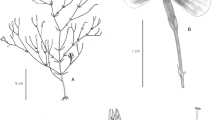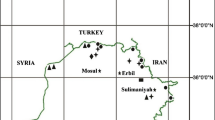Abstract
Calopogonium mucunoides Desv. (Fabaceae), alien to the Indian flora, was discovered from two locations of the east coastal plains of agro-ecological zone of Odisha state. After critical review of published literature on the distribution, its natural occurrence in Odisha was found to be a new record for the eastern and central India. The present report deals with its taxonomic description, ecology and potentiality of the species for further economic utilization.







Similar content being viewed by others
References
Khuroo AA, Reshi ZA, Malik AH, Weber E, Rashid I, Dar GH (2011) Alien flora of India: taxonomic composition, invasion status and biogeographic affiliations. Biol Invasions 14:99–113
Mabberley DJ (1997) The plant book: a portable dictionary of the vascular plants, 2nd edn. Cambridge University Press, Cambridge, p 117
Anonymous (2013a) The plant list (2013): version 1.1. A working list of all plant species. In: Royal Botanical Garden, Kew/Missouri Botanical Garden. Published on the internet. http://www.theplantlist.org. Accessed 1 Jan 2013
Anonymous (2005) Calopogonium mucunoides. online database. www.flowersofindia.net/catalog/slides/calopo.html
Saldanha CJ (1984) Flora of Karnataka, vol 1. Oxford & IBH Publishing Co., New Delhi, pp 424–425
Nair NC, Henry AN (1989) Flora of Tamilnadu, India, Series I: analysis, vol 1. Botanical Survey of India, Southern Circle, Coimbatore, p 93
Vajravelu E (1990) Flora of Palghat district, including Silent valley national park. Botanical Survey of India, Howrah, Kerala (Flora of India), p 646
Backer CA, Bakhuizen VB (1963) Flora of Java, vol 1. Noordhoff-Groningen, The Netherlands, pp 630–631
Anonymous (1965) Indian central coconut committee. 19th Ann Rep Part-I, p 9
Barman D, Jakhar P, Hombe Gowda HC (2006) Sisal cultivation: an economic opportunity in shifting cultivated degraded land of Eastern Ghat region. Indian J Hill Farm 19(1 & 2):16–18
Mani M (2010) Origin, introduction, distribution and management of the invasive spiraling white fly Aleurodiscus dispersus Russel in India. Karnataka J Agric Sci 23(1):59–75
Karthikeyan A, Bhaskaran R (2001) Effects of intercrops in the intensity of basal stem rot of coconut and soil microbial population. Trop Agric Res Ext 4(2):117–119
Trivedi BK (2002) Grasses and legumes for tropical pastures. Indian Grassland and Fodder Research Institute (ICAR), Jhansi, India
Haines HH (1921–25) The botany of Bihar and Orissa, 6 parts. Adlard & Son and West Newman Ltd, London
Saxena HO, Brahmam M (1994) The flora of Orissa, vol 1. Orissa Forest Development Corporation Ltd, Bhubaneswar
Brandis D (1874) The forest flora of north west and central India. Bishen Singh Mahendrapal Singh, Dehradun (Rep 1972)
Verma DM, Pant PC, Hanfi MI (1985) Flora of Raipur, Durg & Rajnandgaon: flora of India Series 3. Botanical Survey of India, Howrah
Patel RI (1968) Forest Flora of Melghat. Bishen Singh Mahendrapal Singh, Dehradun
Prain D (1963) Bengal Plants, vol 1. Botanical Survey of India, Howrah
Mukherjee AK (1984) Flora of Pachmari and Bori reserves, Madhya Pradesh: flora of India Series 3. Botanical Survey of India, Howrah
Tiwari SDN (1979) The phytogeography of legumes of Madhya Pradesh. Bishen Singh Mahendrapal Singh, Dehradun
Doyle JJ, Chappill JA, Bailey CD, Kajita T (2000) Towards a comprehensive phylogeny of legumes: evidence from rbcL sequences and non-molecular data. In: Herendeen PS, Bruneac A (eds) Advances in legume systematics 9. Royal Botanic Gardens, Kew, pp 1–20
Lee J, Hymowitz T (2001) A molecular phylogenetic study of the sub-tribe Glycininae (Leguminosae) derived from the chloroplast DNA rps 16 intron sequences. Am J Bot 88(11):2064–2073
Doyle JJ, Doyle JL, Harbison C (2003) Chloroplast expressed glutamine synthetase in Glycine and related leguminosae: phylogeny, gene duplication and ancient polyoloidy. Syst Bot 28:567–577
Mecha I, Adegbola TA (1980) Chemical composition of some southern Nigeria forage eaten by goats. In: Le Houerou HN (ed) Browse in Africa the current state of knowledge. ILCA, Addis Ababa, pp 303–306
Mackinder B, Pasquet R, Polhill R, Verdcourt B (2001) Flora Zambesiaca FZ, vol 3 part: 5, Leguminosae. Kew Royal Botanical Gardens, Kew
Dinesh R (2004) Long term effects of leguminous cover crops on microbial indices and their relationships in the soils of a coconut plantation of a humid tropical region. J Plant Nutr Soil Sci 167(2):189–195
Anonymous (2012) Annual Report of the National Bureau of plant genetic resources 2011–2012. NBPGR, Pusa Campus, New Delhi, pp 54–62
Kandji ST, Verchot L, Mackensen J (2006) Climate change and variability in the Sehel Region: Impacts and adaption strategies in the agricultural sector. Kenya, World Agroforestry Centre, p 16
Johnson DE (2013) Weed management in small holder rice production in the tropics. In: Radcliffe’s IPM World Text Book, University of Minnesota, USA. Published on internet: http://ipmworld.umn.edu/chapters/johnson.htm
Fairhurst T (2012) Handbook for integrated soil fertility management. Kenya, Africa Soil Health Consortium, p 50
Acknowledgments
The authors are grateful to the Director, National Bureau of Plant Genetic Resources, New Delhi for providing facilities and approving the exploration and germplasm collection programme and to Dr. E. R. Nayar, Head, Division of Plant Exploration and Germplasm Collection, NBPGR, New Delhi for providing information on germplasm introduction and authentic records of herbarium specimens from south India represented in the NHCP, New Delhi.
Author information
Authors and Affiliations
Corresponding author
Rights and permissions
About this article
Cite this article
Misra, R.C., Pani, D.R. Note on Calopogonium mucunoides Desv. (Fabaceae): A New Species Record for Eastern and Central India. Proc. Natl. Acad. Sci., India, Sect. B Biol. Sci. 86, 211–216 (2016). https://doi.org/10.1007/s40011-014-0442-4
Received:
Revised:
Accepted:
Published:
Issue Date:
DOI: https://doi.org/10.1007/s40011-014-0442-4




